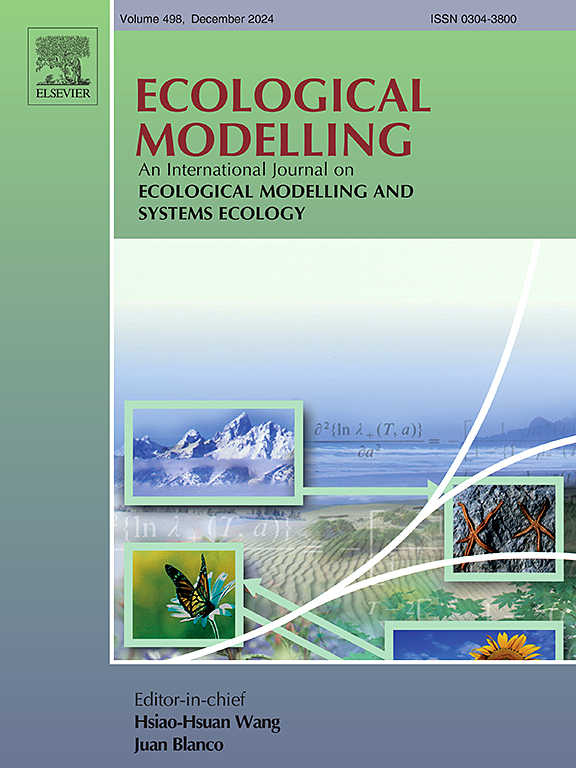模拟蜱虫觅食的物候错配和宿主人口更替对莱姆病危害的影响
IF 3.2
3区 环境科学与生态学
Q2 ECOLOGY
引用次数: 0
摘要
气候变化正在改变生态上相互影响的物种的季节丰度和活动模式。目前尚不清楚蜱虫及其宿主之间的物候变化将如何影响蜱虫的摄食、存活以及摄食期间病原体传播的时间和概率。据观察,人类莱姆病病例的季节性时间已经提前,伴随着发病率的增加,这可能反映了蜱虫寻食物候的变化。我们提出了一个探索蜱传病原体季节动态的数学模型框架。该模型对最近开发的以小型和大型宿主为食的伊科蜱季节性种群矩阵模型进行了扩展:i)纳入了病原体(基于莱姆病的病原体--广义鲍瑞氏菌)在蜱和有储藏能力的小型哺乳动物宿主之间的传播;ii)纳入了小型哺乳动物宿主的季节性人口更替。通过修改模型参数,我们探索了蜱虫寻食物候学、蜱虫宿主选择和宿主繁殖季节性等不同情况对疾病动力学的影响。我们的模型预测,由于小型哺乳动物宿主的生活史不同,它们的季节性感染率要比蜱媒介的感染率变化大得多。宿主人口的快速更替对于清除小型哺乳动物种群中的感染非常重要。宿主繁殖的季节性时间与蜱虫求偶的物候学之间的一致性是该模型的一个关键特征,因为它决定了病原体在宿主和媒介种群中的传播和感染率。该模型预测,蜱幼虫取食与小宿主繁殖之间的不同步会增加受感染的求偶若虫数量,这是衡量莱姆病危害的常用指标。当蜱幼虫取食与小宿主繁殖不同步时,幼虫主要取食较老的宿主,而较老的宿主更有可能受到感染。我们的模型提供了一个适应性强的框架,可用于探索新出现的蜱传疾病系统中病原体动态、宿主人口统计和媒介生活史特征之间的季节性关系。本文章由计算机程序翻译,如有差异,请以英文原文为准。

Modeling the effects of phenological mismatch in tick questing and host demographic turnover on Lyme disease hazard
Climate change is altering the seasonal abundance and activity patterns of ecologically interacting species. It is not yet known how changes in phenological alignment between ticks and their hosts will impact tick feeding, survival, and the timing and probability of pathogen transmission during feeding. It has been observed that the seasonal timing of human Lyme disease cases has shifted earlier, accompanying an increased incidence, which may reflect changes in tick questing phenology. We present a mathematical model framework for exploring the seasonal dynamics of a tick-borne pathogen. The model extends a recently developed seasonal population matrix model for ixodid ticks feeding on a small and a large host, to i) incorporate the transmission of a pathogen, based on the causative agent of Lyme disease, Borrelia burgdorferi sensu lato, between ticks and a reservoir-competent small mammal host, and ii) include seasonal demographic turnover in the small mammal host. Through modification of model parameters, we explored the effects of alternative scenarios for tick questing phenology, tick host selection, and seasonality of host reproduction on disease dynamics. Our model predicts that due to differences in their life history, seasonal infection prevalence is much more variable in the small mammalian host than in the tick vector. The rapid pace of host demographic turnover is important for clearing infection in the small mammal population. The alignment between the seasonal timing of host reproduction and tick questing phenology is a critical feature in the model, as it determines pathogen transmission and infection prevalence in host and vector populations. The model predicts that increased asynchrony between larval tick feeding and small host reproduction can increase the number of infected questing nymphs, a common metric for Lyme disease hazard. When larval tick feeding is misaligned with small host reproduction, the larvae feed predominantly on older hosts, which are more likely to be infected. Our model presents an adaptable framework for exploring seasonal relationships between pathogen dynamics, host demography, and vector life history traits in an emergent tick-borne disease system.
求助全文
通过发布文献求助,成功后即可免费获取论文全文。
去求助
来源期刊

Ecological Modelling
环境科学-生态学
CiteScore
5.60
自引率
6.50%
发文量
259
审稿时长
69 days
期刊介绍:
The journal is concerned with the use of mathematical models and systems analysis for the description of ecological processes and for the sustainable management of resources. Human activity and well-being are dependent on and integrated with the functioning of ecosystems and the services they provide. We aim to understand these basic ecosystem functions using mathematical and conceptual modelling, systems analysis, thermodynamics, computer simulations, and ecological theory. This leads to a preference for process-based models embedded in theory with explicit causative agents as opposed to strictly statistical or correlative descriptions. These modelling methods can be applied to a wide spectrum of issues ranging from basic ecology to human ecology to socio-ecological systems. The journal welcomes research articles, short communications, review articles, letters to the editor, book reviews, and other communications. The journal also supports the activities of the [International Society of Ecological Modelling (ISEM)](http://www.isemna.org/).
 求助内容:
求助内容: 应助结果提醒方式:
应助结果提醒方式:


